1.1 Newton's law of universal gravitation
1/13
There's no tags or description
Looks like no tags are added yet.
Name | Mastery | Learn | Test | Matching | Spaced |
|---|
No study sessions yet.
14 Terms
Newton’s law of universal gravitation
states that any two bodies in the universe attract each other with a force that is directly proportional to its mass and inversely proportional to the square of the distance between them.
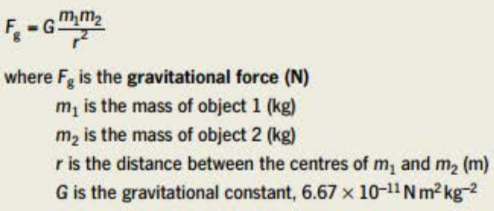
Inverse square law (formula)
describes the strength of the gravitational force between the two attracting objects as the distance increases. If r increases, Fg will decrease dramatically)
If the law of universal gravitation predicts that any two objects that have mass will attract each other, why don’t we notice ourselves and the person next to us being forced to attract?
The value of the G (gravitational force) is too small that the attraction between two everyday objects, such as yourself and your neighbour, cannot be noticed. Also, the mass of everyday objects is smaller than celestial bodies (planets etc.) hence the force can be considered negligible.
How does the law of universal gravitation apply to the Earth and Moon using Newton’s Laws?
Newton’s third law - forces occur in action-reaction pairs hence Earth exerts a gravitational force onto the Moon as well as the Moon exerting an equal and opposite force on the Earth according to the law of universal gravitation.
Newton’s second law - the effect of the gravitational force of the Moon onto the Earth is much smaller due to Earth larger mass. This results in the Moon orbiting the Earth due to the gravitational attraction between them.
How are the acceleration of the planet’s orbits effected by the law of universal gravitation?
Based on the Earth-Moon system, due to the Moon’s smaller mass in comparison to the Earth, the acceleration of the Moon is many times greater than that of the Earth (which is why it orbits the Earth rather the Earth orbiting the Moon). Though, the Moon’s gravitational force still effects the Earth by causing its’ tides.
Similar idea is applied between the Sun and the rest of the Solar system due to their differentiating masses.
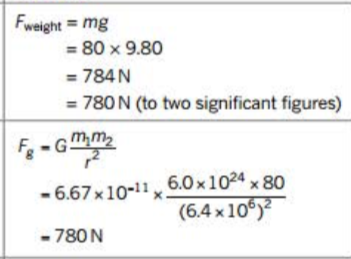
Weight = Gravitational force (formula)
Weight is another name for gravitational force acting on an object near the Earth’s surface. (It is seen both formulas provide the same answers given that the distance in these calculations is between the centres of the two objects (a.k.a radius of the Earth))
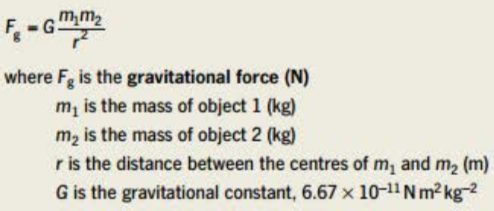
Why does the strength of Earth’s gravity reduce as you travel away from Earth? (hint: use inverse square law)
Acceleration of objects near the surface of the Earth is a result of the Earth’s mass and radius hence a planet with a different mass/radius will develop a different value for g. Hence, due to inverse square law, if an object is above the Earth’s surface, the value of the r (radius) will be greater and the value of g will be smaller. Hence, as proven.
what is apparent weight? what is true weight?
Apparent weight is the feeling of the normal force (in a given situation) changing; hence, it may feel greater or smaller than your true weight due to extra forces like acceleration and inclination.
True weight: just gravity pulling on you.
When weight and normal force are the same…
…the normal force matches the same forces of the object’s weight hence there is no ‘apparent weight’. (e.g. you standing still on the ground. you feel your normal weight)
When weight and normal force are not the same… (accelerating elevator example)
…if the elevator is speeding up or down, the normal force or the ‘apparent weight’ changes.
going up = contact force (normal force) increases hence you feel heavier.
going down = contact force decreases hence you feel lighter.
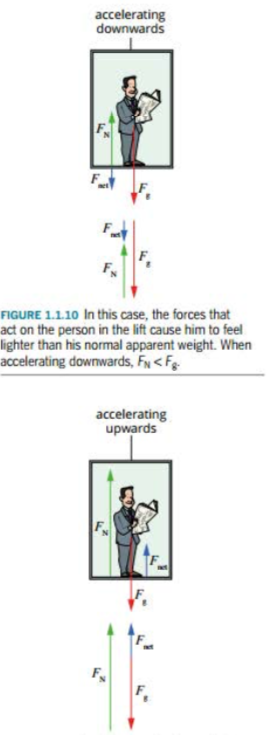
Vector sum of the apparent weight (normal reaction force) and the force due to gravity (weight force). What does the net force cause?
These vectors together gives the net force that causes acceleration.
What is apparent weightlessness and when does it occur on Earth?
Apparent weightlessness is when you don’t feel any contact force pushing back on you hence you feel like you weigh nothing even though gravity is still pushing onto you. On Earth, this can occur when you are in free-fall like going down on an elevator. When you accelerate down at the same rate as the elevator, the force of the floor doesn’t push you up hence you feel ‘weightless’.
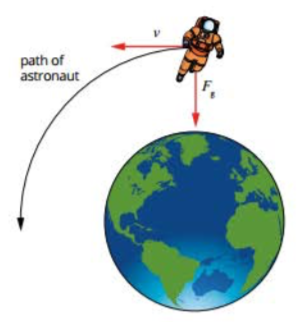
How does apparent weightlessness occur in orbit? (astronaut example)
Astronauts feel weightless when in space because they are in continuous free fall. Although they are falling towards Earth due to gravity, the rapid force of acceleration sideways causes them to never hit the Earth’s ground hence never feeling that ‘weight force’. This can show a curvature vector like on the diagram.
Difference between apparent weightlessnss and true weightlessness
True weightlessness: only occurs when the gravitational field strength is zero hence F-weight = 0. This is applicable for deep space activity, far from any planet.
Apparent weightlessness: can occur when still under the influence of a gravitational field.
(Simply, apparent weightlessness is the ‘feeling of being weightless’ which it isn’t true you are weightless because gravity is still pulling you but true weightlessness is purely because gravity isn’t pulling you at all)